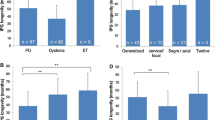Abstract
Background
Electrode fractures are known hardware problems in patients with deep brain stimulation (DBS) and require surgical revision. Short circuits, loose connections or disconnections of only single contacts of the common quadripolar stimulation electrodes are more subtle dysfunctions and can result in decreased efficacy of DBS. Measuring the impedances of electrodes helps detect such technical dysfunctions. This study evaluates the frequency and clinical implications of abnormal impedance measurements.
Methods
We retrospectively analyzed findings of systematic impedance checks in 591 consecutive patients with DBS for various movement disorders treated in our DBS center between 2005 and 2010.
Findings
A technical dysfunction was found in 36 out of 1,142 electrodes (3.2%). Short circuits (22 electrodes) were more frequent than disconnections of single contacts (8 electrodes) or loose contacts (6 electrodes). Moreover, after 109 replacements of impulse generators another 16 electrodes revealed technical dysfunctions, again with short circuits (9 electrodes) exceeding disconnections of single contacts (5 electrodes) and loose contacts (2 electrodes). Most of the short circuits occurred immediately after surgical interventions. In contrast, among dysfunctions occurring later during long-term DBS, disconnections and loose contacts prevailed. Surgical revision was performed in 4 of the overall 52 electrodes with dysfunctions, whereas in the other electrodes adjustment of stimulation parameters resulted in stable and satisfying symptom control.
Conclusions
Technical dysfunctions of stimulation electrodes or extension leads are rare but important sources of unsatisfying DBS efficacy. In the majority of cases DBS programming or reprogramming allows avoiding surgical revision.
Similar content being viewed by others
References
Allert N, Dohle C, Horn JW, Kelm S, Kirsch H, Nolte PN, Weirich W, Karbe H (2011) Rehabilitation of Parkinson patients with deep brain stimulation—Experiences of the Neurological Rehabilitation Center Godeshoehe. Nervenarzt 82:462–467
Allert N, Kirsch H, Weirich W, Karbe H (2009) Stability of symptom control after replacement of impulse generators for deep brain stimulation. J Neurosurg 110:1274–1277
Benabid AL, Chabardes S, Mitrofanis J, Pollak P (2009) Deep brain stimulation of the subthalamic nucleus for the treatment of Parkinson's disease. Lancet Neurol 8:67–81
Blomstedt P, Hariz MI (2005) Hardware-related complications of deep brain stimulation: a ten year experience. Acta Neurochirurgica 147:1061–1064
Burdick AP, Foote KD (2011) Advancing deep brain stimulation for obsessive-compulsive disorder. Expert Rev Neurother 11:341–344
Butson CR, Maks CB, McIntyre CC (2006) Sources and effects of electrode impedance during deep brain stimulation. Clin Neurophysiol 117:447–454
Fernández FS, Alvarez Vega MA, Antuña Ramos A, Fernández González F, Lozano Aragoneses B. Lead fractures in deep brain stimulation during long-term follow-up (2010) Parkinsons Dis 2010:409356
Fisher R, Salanova V, Witt T, Worth R, Henry T, Gross R, Oommen K, Osorio I, Nazzaro J, Labar D, Kaplitt M, Sperling M, Sandok E, Neal J, Handforth A, Stern J, DeSalles A, Chung S, Shetter A, Bergen D, Bakay R, Henderson J, French J, Baltuch G, Rosenfeld W, Youkilis A, Marks W, Garcia P, Barbaro N, Fountain N, Bazil C, Goodman R, McKhann G, Babu Krishnamurthy K, Papavassiliou S, Epstein C, Pollard J, Tonder L, Grebin J, Coffey R, Graves N, SANTE Study Group (2010) Electrical stimulation of the anterior nucleus of thalamus for treatment of refractory epilepsy. Epilepsia 51:899–908
Flora ED, Perera CL, Cameron AL, Maddern GJ (2010) Deep brain stimulation for essential tremor: a systematic review. Mov Disord 25:1550–1559
Hamani C, Lozano AM (2006) Hardware-related complications of deep brain stimulation: a review of the published literature. Stereotact Funct Neurosurg 84:248–251
Holtzheimer PE 3rd, Mayberg HS (2010) Deep brain stimulation for treatment-resistant depression. Am J Psychiatry 167:1437–44
Kupsch A, Benecke R, Müller J, Trottenberg T, Schneider GH, Poewe W, Eisner W, Wolters A, Müller JU, Deuschl G, Pinsker MO, Skogseid IM, Roeste GK, Vollmer-Haase J, Brentrup A, Krause M, Tronnier V, Schnitzler A, Voges J, Nikkhah G, Vesper J, Naumann M, Volkmann J, Deep-Brain Stimulation for Dystonia Study Group (2006) Pallidal deep-brain stimulation in primary generalized or segmental dystonia. N Engl J Med 355:1978–90
Moro E, Allert N, Eleopra R, Houeto JL, Phan TM, Stoevelaar H, International Study Group on Referral Criteria for DBS (2009) A decision tool to support appropriate referral for deep brain stimulation in Parkinson's disease. J Neurol 256:83–88
Oh MY, Kim SH, Lang AE, Lozano AM (2002) Long-term hardware-related complications of deep brain stimulation. Neurosurgery 50:1268–1276
Schuurman PR, Bosch DA, Bossuyt PM, Bonsel GJ, von Soeren EJ, de Bie RM, Merkus MP, Speelman JD (2000) A comparison of continuous thalamic stimulation and thalamotomy for suppression of severe tremor. N Engl J Med 342:461–468
Acknowledgments
We gratefully acknowledge the excellent support in the management and follow-up of DBS patients by Caroline Mehnert (PD nurse).
Conflicts of interest
Dr. Niels Allert has received honoraria from Medtronic for lecturing and consulting services.
Author information
Authors and Affiliations
Corresponding author
Rights and permissions
About this article
Cite this article
Allert, N., Markou, M., Miskiewicz, A.A. et al. Electrode dysfunctions in patients with deep brain stimulation: a clinical retrospective study. Acta Neurochir 153, 2343–2349 (2011). https://doi.org/10.1007/s00701-011-1187-y
Received:
Accepted:
Published:
Issue Date:
DOI: https://doi.org/10.1007/s00701-011-1187-y




